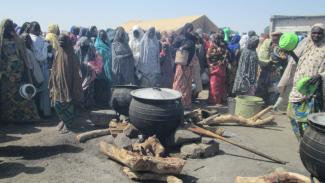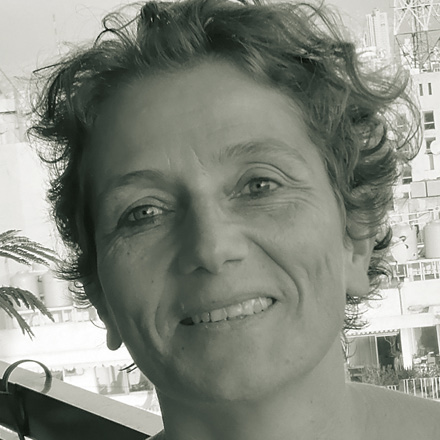Internally displaced persons
Refugees in their own country

Atine’s life seemed easy sailing about a year ago. The girl from Baga in Borno State was in her last year of primary school. Her father worked at a local factory where catfish is smoked before it is transported for sale to other parts of the country. Her mother was a housewife who looked after her four children and was pregnant again.
Residents of the town were aware of the terrorist group Boko Haram. But the family had a sense of safety – after all, the headquarters of the Multinational Joint Task Force (MNJTF), an international force of soldiers from Nigeria, Niger and Chad, was stationed in their town. The Joint Force was established to deal with cross-border security and also helped combat Boko Haram.
Atine’s world crashed in January 2015 when Boko Haram attacked the town, killing residents, razing homes and forcing survivors to flee. “The men were shot at sight, my father included. My older brother also died. We ran away, trekking for days in the bush, and eventually found our way to Maiduguri. My mother miscarried because of the stress,” she says in Hausa, her native language.
Atine and her mother now live in a camp for IDPs in Kuchingoro, which is part of the Abuja agglomeration. Unfortunately, the camp, which is home to almost 800 people, is not a formal one designated by government. Like several other such camps in Abuja, internal refugees who had nowhere else to go started it on empty patches of land.
It is evident that the camp is unplanned; makeshift homes are constructed with roofing sheets, tarpaulin and plastic wraps. The sanitary condition is deplorable: toilets are unavailable, and residents defecate in plastic bags they dispose in refuse heaps nearby. The stench is awful. A single borehole serves the water needs of the residents.
From a similar camp in Oronzo, also in Abuja, several young boys troop into the city every day to find work and earn some money. Hassan, 14, says he does menial jobs at a local market nearby, for which he earns a pittance: “I carry loads for people at the market, some days I earn 500 naira (about $ 2.5) and on good days I make 1000 naira.” He says a friend of his convinced someone to teach him carpentry, and adds: “I hope that artisan will take me on too, so I can learn a vocation.” He says he cannot afford to go back to school.
Formal camps
While the camps in Abuja are informal, the government has set up several camps for those displaced from – or within – the six states most affected by the violence: Borno, Bauchi, Yobe, Taraba, Gombe and Adamawa. There are four official camps in Yola, Adamawa State, while there are two in Damaturu, Yobe State. In Maiduguri there are about 28 camps. Informal camps, which are regarded officially as “camp-like sites”, sprang up all over the states affected and in neighbouring states.
The official camp in Gombe State has been closed down again as the people were resettled. According to Nigeria’s President Muhammadu Buhari, at least 2 million people have been displaced by the activities of the terrorist group, with more than 10,000 people killed in the past six years. The Displacement Tracking Matrix (DTM) set up by the International Organization for Migration (IOM) in collaboration with the National Emergency Management Agency (NEMA) identified 1,818,469 registered IDPs displaced by insurgency in Nigeria in its December 2015 report. Borno State has the highest number of IDPs with 1,434,149 .
Eight percent of the IDPs live in camps while the others reside with host communities, friends and relatives across the country. More than half of the IDP population are children. The DTM has identified 78 camps and camp-like sites. Most of the camps are located in schools and government buildings. Life in the formal camps is hard, however, especially because they are overcrowded.
Toilet facilities in 47 camps are reported to be in bad conditions while only 19 camps have good toilet facilities. In ten camps, the toilets were declared to be not usable. The DTM Nigeria Report Round VII of December 2015 identified malaria to be the most prevalent health problem followed by fevers, coughs, diarrhoea, malnutrition, respiratory tract infections and skin diseases. Thirty-two camps do not have a waste disposal system, and 63 do not have good drainage systems. The report noted open defecation in 52 camps.
In early 2015, an undercover reporter from the International Centre for Investigative Reporting (ICIR) reported grim tales of rape and human trafficking in some of the camps. Girls were being raped by fellow IDPs, and children being sold for as little as $ 250. The government set up an investigative panel, which said that two girls “might have been raped” but that there was no substantial proof to establish the allegations .
The DTM report of October 2015, on the contrary, took note of reports of exchange of food or goods for sex in four camps, while in six camps, children were involved in forced labour and begging. In eight camps, physical and emotional abuses of children were reported. There have also been reports of arrests of NEMA officials for selling relief materials meant for IDPs. Despite the presence of security officials at the camps, two explosions killed more than ten people in two camps in Yola, Adamawa State. Allegedly, Boko Haram militants disguised as IDPs and entered the camps.
Compared with formal camps, informal camps are more dependent on charity. Several NGOs, corporate organisations, individuals, donor agencies and faith-based organisations donate food and medicine. They do voluntary humanitarian work and provide services including health checks and counselling.
IDPs only have limited access to education facilities however. In the worst hit states, many schools have been closed for more than 18 months. According to UNICEF, more than 1200 schools were attacked by Boko Haram since 2009. It made international headlines when Boko Haram kidnapped 276 girls from a school in Chibok, Borno State, in April 2014. The victims have not been liberated. For obvious reasons, many students and teachers shied away from the few schools that managed to stay open.
According to the DTM report, children have access to education in 40 of the 76 formal camps. In the camps outside the troubled areas, NGOs volunteer to teach children. In Kuchingoro camp, where Atine lives, the Australian government has donated chairs and desks for the pupils who learn in classes set up under trees for shelter. Volunteers from the women’s group of ECWA, a faith-based organisation, teach pupils. Christ Tabernacle Church, another faith-based organisation, has provided about 250 school uniforms. Studying in the open, however, means that classes cannot be held when it rains or when it gets too hot.
In November, the government reopened hundreds of schools across the northeast, but attendance remains low. Boko Haram attacks still occur although a regional offensive made up of troops from Nigeria, Cameroon, Chad and Niger has largely weakened the terrorists and reclaimed most of the territories they occupied in the northeast. The government also set up a Victim Resettlement Fund to assist IDPs.
NEMA spokesman Sanni Datti says the government’s assistance extends to IDPs who live outside the formal designated camps. “Because they are registered, even though they live in host communities, we distribute welfare items to them too. Their most basic need is food, but we also provide non-food items such as clothing, beddings and others,” he said. NEMA cooperates with several NGOs and donor agencies to provide vocational training for IDPs.
The government recently announced plans to begin winding down the camps and to resettle the IDPs. It also promised to rebuild infrastructure that has been destroyed. But while many refugees want to return to their homes, they are concerned about the security situation. Moreover, the region’s economy is in shambles.
According to the DTM, some 320,000 IDPs have returned to northern Adamawa State. The security situation has improved thanks to increased military presence in the area. In August, about 10,000 Nigerians who had sought refuge in Cameroon were repatriated: some have returned to their communities in Adamawa, while some were relocated to IDP camps in Borno State.
Atine yearns for a normal life again, but does not want to return to Baga: “I will be too scared because my father and brother were killed there. Maybe we can move out of this camp and find somewhere near Abuja to live. I just want to leave this place, there are too many people,” she says.
Damilola Oyedele is a senior correspondent for Thisday, a Nigerian newspaper. She lives in Abuja.
damiski22@yahoo.com
Link:
DTM Nigeria Report Round VII:
http://nigeria.iom.int/sites/default/files/dtm/01_IOM%20DTM%20Nigeria_Round%20VII%20Report_20151223.pdf











